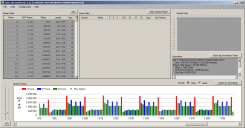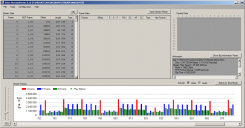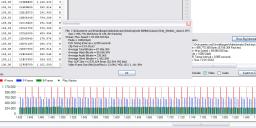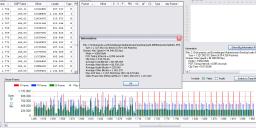
AVCHD maximum image quality settings and testing
-
Are those patterns normal?
It only appear after ~30 sec. Not every clip has it.
My settings are:
Video Bitrate 24H=42000000
Video Bitrate 24L=32000000
Video Bitrate FSH/SH=42000000
Video Bitrate FH/H=32000000
Auto Quantizer for 1080 modes=3 - Most to details
Auto Quantizer for 720 modes=3 - Most to details
What should I change to avoid this? I'm a confused noob :\
 Capture-1.png1289 x 673 - 53K
Capture-1.png1289 x 673 - 53K
 Capture-2.png1289 x 673 - 53K
Capture-2.png1289 x 673 - 53K -
Come on guys... we've clearly identified the low GOP problem. As the saying goes - insanity is repeating the same thing and expecting a different outcome. The low GOP stuff doesn't work - Vitaliy is fixing it - we need to drop it and wait. His request to test longer GOP's will help him get to the bottom of it - lets help him out.
Chris -
Chris, that is a VERY good idea cutting back on light level on a high rez chart!
Also, I can suggest that we do not stop down the aperture since this will cause lens diffraction at higher f-stops.
We're probably better off increasing the shutter speed. This way the test can be more repeatable between firmware changes. -
I didn't touch GOP, I don't understand it. I get the cadence issue on default GOP values.
I went back to the footage I shot with the previous PTool version with a 32000000 bitrate as the only modified setting and a few shots have the cadence issue as well. -
With 3.62 I don't see a benefit from lower GOPs than 12. It doesn't seem to make it anymore reliable to goto 12 rather than 3 or 6 with this version of ptool either.
-
@cbrandin
this help me to understand avchd a lot.
http://avidemux.org/admWiki/doku.php?id=tutorial:h.264
there is one interesting thin about Inloop Deblocking filter.
qoute
Loop Filter: This setting controls one of x264' most important features: the Inloop Deblocking filter. In contrast to MPEG-4 ASP (DivX, Xvid, etc.) the Inloop Deblocking is a mandatory feature of the H.264 standard. So the encoder, x264 in this case, can rely on the decoder to perform a proper deblocking. Furthermore all P- and B-Frames in H.264 streams refer to the deblocked frames instead of the unprocessed ones, which improves the compressibility. There is absolutely no reason the completely disable the Inloop Deblocking, so it's highly recommended to keep it enabled in all cases. There are two settings available to configure the Inloop Deblocking filter:
Strength: This setting is also called “Alpha Deblocking”. It controls how much the Deblocking filter will smooth the video, so it has an important effect on the overall sharpness of your video. The default value is 0 and should be enough to smooth out all the blocks from your video, especially in Quantizer Modes (QP or CRF). Negative values will give a more sharp video, but they will also increases the danger of visible block artifacts! In contrast positive values will result in a smoother video, but they will also remove more details.
Threshold: This setting is also called “Beta Deblocking” and it's more difficult to handle than Alpha Deblocking. It controls the threshold for block detection. The default value is 0 and should be enough to detect all blocks in your video. Negative values will “save” more details, but more blocks might slip through (especially in flat areas). In contrast positive values will remove more details and catch more blocks.
Remarks: Generally there is no need to change the default setting of 0:0 for Strength:Threshold, as it gives very good results for a wide range of videos. Nevertheless you can try out different settings to find the optimal settings for your eyes. If you like a more sharp video and don't mind a few blocks here and there, then you might be happy with -2:-1. This might also be worth a try for MPEG-4 ASP (DivX, Xvid, etc.) users! If you like a smooth and clean image or encode a lot of Anime stuff, then you can try something like 1:2. Nevertheless you should not leave the range between -3 and +2 for both settins!
now we have high bitrates so we need Ptool option to disable loop filter and get beter detalis and sharpness.
this is interesting too...
http://www.nabanet.com/wbuarea/library/docs/isog/presentations/2011/2.2.3%20PLauzon.pdf
130 mbit LONG GOP for visualy losless.
so all that playing with low gop is just a vaste of time if we need max quality..
what we need is stable high bitrate pach about 88 to 110 mbit with 12 gop and Auto Quantizer 4 with option to disable some avchd codec modes wich are used for low bit rate .
sorry for my bad english and thank u ... -
@vladnik
This is why I asked to test GOP=24 in 1080p24, as PTool have all calculation support for such GOP.
Unfortunately no one noticed it. -
I've modified my Set B posted above (with Frame Buffer Sizes and Encoder Frame Limit values multiplied by 4).
Actually I wanted to lower the Bitrate from 66 to 52Mbits ... but interesstingly with the lower Bitrate I got card speed errors.
Out of interesst I've tried 88Mbits (so the 24H default value multiplied by 4).
The cool thing is the setting also works perfectly with my Class 6 cards!*
Streamparser shows no uneven candance ... and while the I-Frames are in the same ballpark as with my 66Mbits posted above, the P and B frames get larger with the new 88Mbits setting.
First Streamparser screenshot shows the last sequence of a 90'' clip. It's a high detailed still scene (actually not really still, but very little motion) and the cadence is even. The second screenshot shows a part of a 2' clip - going from heavy motion (on the left side of the graph) to no motion (on the right side of the graph). As far as I can tell the Streamparser graphs look very good...
From my initial tests the footage looks fine (24p, 50i, 720p50... all also in Ex Tele Mode and at all ISOs). So I will keep testing with these settings. By now I've only tested with manual focus lenses... I have to check whether or not there are issues with AF lenses.
Setting attached:
24H 88Mbits, FSH 32Mbits
1080 AQ4, 720 AQ2
all GOP12
FBS + EFL x4
The 100Mbit MJPEG setting is also included.
So far so good ...
P.S. ... I will also test this exact setting with GOP24 as suggested
* edit: Class 6 cards work fine for recording, but in camera playback doesn't work @24p.
With class 10 cards in camera playback works fine.

 setb_24p_88mbits_highdetail_still.jpg1218 x 540 - 232K
setb_24p_88mbits_highdetail_still.jpg1218 x 540 - 232K
 setb_24p_88mbits_highdetail_motion.jpg1270 x 592 - 264K
setb_24p_88mbits_highdetail_motion.jpg1270 x 592 - 264K
 setb.zip530B
setb.zip530B -
okay, from a first test I would say GOP24 alone is not going to improve anything...
I've used my "SetB" and just changed the GOP length from 12 to 24.
Bitrate goes down from ~85Mbits to 45Mbits. P-Frames and B-Frames are much smaller.
With heavy motion (see right hand side of the streamparser screenshot) the size of the I-Frames go down significantly (compared to the same setting but with GOP12 as posted above).

 setc_gop24.jpg1262 x 603 - 244K
setc_gop24.jpg1262 x 603 - 244K -
@towi
I tried your GOP12 settings and I like the IQ but the settings are unfortunately not stable. In Ex-tele it breaks and I get card speed errors, also a few times in normal mode. Tried AF and manual focus, all manual, 2 different lenses. The card is freshly formatted with SD formatter. I have the Transcend Class 10 and it always worked before so have no idea what is going on. The images are nice though, and they grade very nicely, so I hope you work it out... -
It seems this topic has morphed somewhat into a testing thread? I'm sure this is difficult to avoid, seeing as there are still many kinks to be worked out in PTools, but perhaps the thread should be relabeled, or its contents split to two threads? Discerning "max quality settings" from the "hey, try this" settings may be confusing for some.
-
@vladnik
Your comments about filters are interesting. With high bitrates, that may be the remaining limiting factor. I think I know how to approach this. Thanks for the idea!
Chris -
@B3Guy
Sure it's a testing thread. The difference is that we are approaching it from an image quality standpoint instead of a maximum bitrate or low GOP standpoint. When we get results that seem good and stable and maximize image quality there will probably be a recommended settings thread as a result. Here, we are still in the research phase.
Chris -
@allenswrench
"The images are nice though, and they grade very nicely"
Yes, I feel the same
"so I hope you work it out... "
I had no errors so far - not with high detailed scenes, neither with fast and complex motion... not even with shooting the codec torture chart or so. Both normal and ExTele Mode. Even on class 6 cards (recording only; in camera playback won't work on class 6).
So I am not sure what to work out ...
There is only the issue with Avid import and ClipWrap's conversion.
But the files run just fine through 5DtoRGB, Neoscene and "Media Converter".
I live in PAL land.... so my camera is set to PAL by default (this is why FSH is set to 32Mbit in my settings as I need very stable 50i frequently ... BTW).
Shouldn't make a difference for 24p ... but maybe worth a try?
My class 10 cards are SanDisk... -
-
@vitaly
difference to what... stability?
Yes, maybe... as I said above I've only tested with MF lenses by now (Nokton 25mm).
I have to check AF lenses (I only own the 14mm and 20mm pancakes, and the weak 14-42 Kit lens though).
Edit:
Maybe also related to the image settings?
I use "smooth" -2|-2|0|-2 all the time -
@vladnik "what we need is stable high bitrate pach about 88 to 110 mbit with 12 gop and Auto Quantizer 4 with option to disable some avchd codec modes wich are used for low bit rate ."
I think this is correct. I was comparing shots this morning, one unhacked and one 88mbit, 12GOP, AQ4. The improvement in image quality is clear but not so much to justify the bitrate which is 10 times higher (B, P, and I frames are all 10 times normal value). I don't know the details of how all this works, but it's clear we don't have a bitrate problem. It's the way the codec is using the bits. -
@vvvfmoron
Well... not 10x, maybe 4x. Still, I think you are right, the codec isn't yet making the best use of the extra bitrate. I would expect a significant difference with 44M and AQ=3 or 4, over the defaults. As bitrates get higher there is a point of diminishing returns, so I would never expect 88M to be twice as good as 44M. At this point I wonder if 88M is better than 44M at all, or if we just end up with extra data that isn't really doing anything. I can definitely see a difference at 44M, and I can measure improvements technically in a repeatable way. Some of the improvements aren't so visible in unprocessed footage, but they make things like grading, etc... work quite a bit better.
Chris -
@cbrandin
I would love to use lower bitrates (smaller files).
Okay, storage is more or less a non-issue, but larger files are also more time consuming.
I've tried your 44Mbit settings... but the P- and B-Frames are realtively small.
Too, in fast motion I-Frames may go down.
So far I was only able to produce quite large I-Frames as well as relatively large P- and B-Frames with my last setting.
In heavy motion I've notived some P-Frames exceed the size of the precedent I-Frame (which, to my knowledge, should create artefacts) ... but I can't find any image degradation or weird behavier in the actual frames of the final movie.
-
>@cbrandin
I'm glad I can help .
h264 is very complex codec , but there is two basic things for real image quality.
Motion estimation and quantization . Other things like loop filter are used to make low bitrate image look beter and they are very processor intensive , so disable them or lower their strenght for high bitrates
can add stability.
I think we need same kind of vanila h264 wich use bitrate only for real image gain .
Vladimir -
@towi
What you are describing is perfectly normal behavior for AVC codecs and would be expected. B frames are supposed to be relatively small. P frames can get big if everything in a frame has changed. If nothing much changes, or the changes are just a reasonably small shift in the image, then P frames don't need to be very big. The issue with big B frames is that can't really improve on the quality of their reference frames - the surrounding P and I frames. Big B frames, more so than P and I frames, end up with a lot of data that isn't really doing much to improve the image. With a lot of motion there is blurring, so I frames shrink because the target quality level can be more easily reached, whereas P frames grow because so much is changing.
Chris -
makes sense - many thanks!
I would have thought the size of the P-Frames is important (adds to IQ), though...
What's the setting you are currently working with? Still the 44Mbit setting with FBS and EFL values doubled and AQ set to 3 or 4?
-
@towi
Yes, those are the settings I currently use. I am playing around with increasing the bitrate to 66M, and leaving the FBS and EFL just doubled.
P-Frames can't really improve on I frame IQ - they can just preserve it. This is by design, if they did add to IQ you would get detail pulsing between I frames and P frames, and that would look bad.
Chris -
"P-Frames can't really improve on I frame IQ - they can just preserve it."
So the larger the P-Frame the better it preserves the IQ of the precedent I-Frame?
Thanks again! -
@towi
Only if the subject has changed. P frames only encode changes to the image and only get big if there are a lot of changes. I frames are stand-alone, they are oblivious to the contents of any other frames, so they can get big even if nothing changes. P frames aren't necessarily dependent on I frames, they can be dependent on a prior P frame as well, as long as there isn't an I frame between them.
Chris
This topic is closed.
← All Discussions Start New Topic


Howdy, Stranger!
It looks like you're new here. If you want to get involved, click one of these buttons!
Categories
- Topics List23,964
- Blog5,723
- General and News1,342
- Hacks and Patches1,151
- ↳ Top Settings33
- ↳ Beginners254
- ↳ Archives402
- ↳ Hacks News and Development56
- Cameras2,361
- ↳ Panasonic990
- ↳ Canon118
- ↳ Sony154
- ↳ Nikon96
- ↳ Pentax and Samsung70
- ↳ Olympus and Fujifilm99
- ↳ Compacts and Camcorders299
- ↳ Smartphones for video97
- ↳ Pro Video Cameras191
- ↳ BlackMagic and other raw cameras121
- Skill1,961
- ↳ Business and distribution66
- ↳ Preparation, scripts and legal38
- ↳ Art149
- ↳ Import, Convert, Exporting291
- ↳ Editors191
- ↳ Effects and stunts115
- ↳ Color grading197
- ↳ Sound and Music280
- ↳ Lighting96
- ↳ Software and storage tips267
- Gear5,414
- ↳ Filters, Adapters, Matte boxes344
- ↳ Lenses1,579
- ↳ Follow focus and gears93
- ↳ Sound498
- ↳ Lighting gear314
- ↳ Camera movement230
- ↳ Gimbals and copters302
- ↳ Rigs and related stuff272
- ↳ Power solutions83
- ↳ Monitors and viewfinders339
- ↳ Tripods and fluid heads139
- ↳ Storage286
- ↳ Computers and studio gear560
- ↳ VR and 3D248
- Showcase1,859
- Marketplace2,834
- Offtopic1,319







